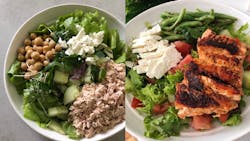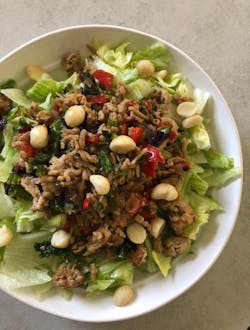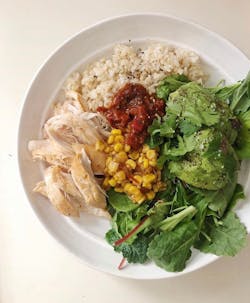Back to Basics: Increasing Nutritious Cooking at the Firehouse
Before I became a nutritionist and educator for fire departments, I never would have guessed that cooking on shift was as difficult as it is or can be. Then I started working with the community.
Like many, I knew that food played a large role within firehouses, but I didn’t know to what extent. Even with old and new fire service culture, meals can be an activity in which all members who are on shift gather and participate, with the potential to serve as bonding time to create relationships. It’s much more than just a meal—it’s downtime between calls, a chance to sit down, touch base and to click refresh. It’s family time.
Thinking about this a bit more, I started to compare cooking at the firehouse to cooking at home. I know how difficult it is to sometimes have everyone eating the same meal (with at least one person choosing a convenient option, such as cereal or a frozen pizza). Just as cooking at home for your own family can be tasking, so can cooking at a firehouse kitchen, but it doesn’t have to be.
The reality of it all is that one of the most prevalent goals that fire departments have in regard to health and wellness is getting back into the kitchen and cooking more. This alone—instead of relying on convenience items that tend to be high in sodium, sugar and calories (such as takeout or frozen options)—can be a game changer by creating a healthy and balanced diet. Simply put, you’re in charge of the ingredients.
The bigger picture
Why is cooking a healthy meal on shift a common goal for fire departments’ efforts to improve health and wellness? In addition to getting back to the basics of fire service culture and to increasing camaraderie, cooking allows firefighters to understand what they’re eating and how it can affect their health.
As we look at the research, it isn’t only important to get in the kitchen but also to create a new tradition of creating healthy meals. Food traditions within fire service culture can serve as a barrier to consuming a healthy diet. A few studies examined the influence of nutrition environments within fire departments on weight statuses of firefighters. It is stated in “Cardiovascular Disease in US Firefighters: A Systematic Review” that typical “firehouse eating culture” tends to revolve around foods that are high in fat and dense in refined carbohydrates and calories. Excess caloric intake because of unhealthy eating habits, such as large portions and snacking, might contribute significantly to some nutrition-related health conditions that exist within the fire service. Add working conditions, cultural traditions and age/generational gaps to the mix, and you can understand that there are barriers to eating healthy while on shift.
Understanding that diet is a modifiable behavioral factor that influences our health, including weight status, heart disease and some cancer risks, is imperative, as is recognizing that specific environmental changes can help to improve firehouse cooking and eating habits.
The solution
Increasing cooking while on shift involves making a meal that everyone (or most) will eat. This in itself can be difficult when you have multiple taste preferences and diet restrictions within a group. Add the fact that we want it to be healthy, tasty, budget-friendly and time-conscious, and we have what might seem like a difficult situation. To improve group meals, we must reach a common medium that takes all of these barriers into consideration. The goal is to showcase flexible, quick and easy meal options that offer a variety of flavors. In an effort to help your fire department to improve its cooking and eating habits, here are some ideas for how to get more people on board to cook (and eat what’s cooked) while on shift:
1) Create a game plan and talk it out. Some groups can make a plan on the fly; others need more time. Communication is key, and it sets your plan up for success or failure. Questions to ask include: What are we making? Will people eat it? Who is cooking? What ingredients are needed? Is the meal feasible with time and budget?
2) Take personal preferences (likes and dislikes), food allergies and intolerances into consideration. Dietary accommodations can be made, so there can be something for everyone (think: low-carb friendly, gluten- and soy-free, variety of nuts, dairy, etc.). One of the best ways to approach making meals that please the masses is simplifying it all and creating consistency. Find what works and continue to do it. Having versatile and flexible options that allow for food swaps are key for dietary preferences and restrictions. For example:
- Rice options—white, brown or cauliflower rice; refined vs. whole grain, such as farrow, quinoa, etc.;
- Sandwich options—white, wheat or multigrain sandwich bread vs. gluten-free sandwich bread; white or whole-wheat flour tortilla vs. grain-free, such as almond or cassava flour tortilla;
- Flour options—white flour, whole-wheat flour, rice flour, almond flour, oat flour, etc.;
- Nuts and seeds—walnuts, almonds, cashews vs. sunflower, chia, hemp seeds, etc.; and
- Dairy and non-dairy—butter, ghee, oil; or avocado, yogurt, sour cream; or dairy, almond, coconut, rice or hemp milk, etc.
3) Incorporate healthy and flexible food swaps to increase versatility and buy-in from individuals. Create options that allow for flexibility because of overlapping ingredients. Take an idea that highlights individuality—such as building a bowl or salad. These dishes allow for different bases (whole-grain or low-carb veggie), protein (ground animal protein, eggs, slow-cooker chicken breast, pan-seared seafood, beans, etc.), toppings (veggies, fruit, nuts, seeds, etc.) and flavors (dressings, marinades, fresh or dried herbs, etc.).
Another idea is to make separate meals or snacks in the same amount of time and effort that’s required for one meal by having overlapping ingredients. An example that I have showcased that goes over well with firefighters is buffalo chicken romaine tacos and teriyaki chicken lettuce wraps. These are two completely different meals and flavor profiles, yet something for everyone: a bunch of overlapping main ingredients, with the sauces (on hand) and toppings changed.An exercise to get you to think about different combinations of what to make involves working backward, or reverse meal planning, as I call it. It’s all about making do with what’s in your refrigerator, freezer and/or pantry by creating a list of meals and snacks that you could prepare. For example: You have a bunch of ingredients on hand and have to figure out what meal you can make with them. The same can be said for snacks. What snacks could you make from pantry staples, such as nuts, seeds, dried fruit, nut butter, oats and sweetener of choice? Using ingredients that you have on hand (previously listed) and then buying some additional ones, some ideas that come to mind include granola, trail mix, energy balls, yogurt bowls and fruit smoothies.
4) Simplify it all. Don’t make it more difficult than it has to be. My suggestion for creating no-stress prep is to make a protein, veggies and grain with simple seasonings and flavors. If you’re up for making extra, these even can be repurposed into a new dish (think about having lunch and dinner covered). Focus on a variety of colors (the brighter the produce, the more nutrient-dense it tends to be). Then make it complex with flavor add-ons, such as sauces, spices and herbs, which can be your best friends. This allows for individuality and for people to make their meals their own.
5) Work with the time that you have. Create a set amount of time that’s dedicated to making the meal, and then choose an ideal cooking temperature or appliance to create quick and easy recipes that you know are reliable across the department. Planning ahead by using downtime to prep also can help with having time on your side. Another option is to use the cooking equipment that’s available to your advantage, with a classic example being the slow cooker (throw a meal together at the beginning of your shift to have it done when it’s dinner time) or use a quick cooking process by using the grill, air fryer or pressure cooker.
6) Lastly, get creative and out of your comfort zone every now and then. Try something new. With practice and consistency, cooking on shift can be part of the firehouse culture that amplifies the health and wellness of firefighters.Question to ask yourself/your department: If I gave your group a set amount of money to use toward shopping for dinner, would you be able to put together a meal that all crew members would eat? Where would you start? What would you make? How long would it take?
I’ve tested this out, so I could see and learn via experience and bring you this information.

Dana Harrison
Dana Harrison, MS, is a nutritionist and educator who is based in Massachusetts. She received a bachelor’s degree in biology from Vassar College and a master’s degree in nutrition science (community nutrition concentration) from University of Massachusetts Amherst. Harrison is the founder of The Cultural Shift Method, which is a nutrition education program that makes nutrition, health and wellness easy, individualized and attainable. She presents simple, realistic, sustainable and dynamic plans for positive health and wellness behaviors, which allow for changes to occur on a cultural level. For more information, visit www.eats2know.com or contact her at [email protected].









